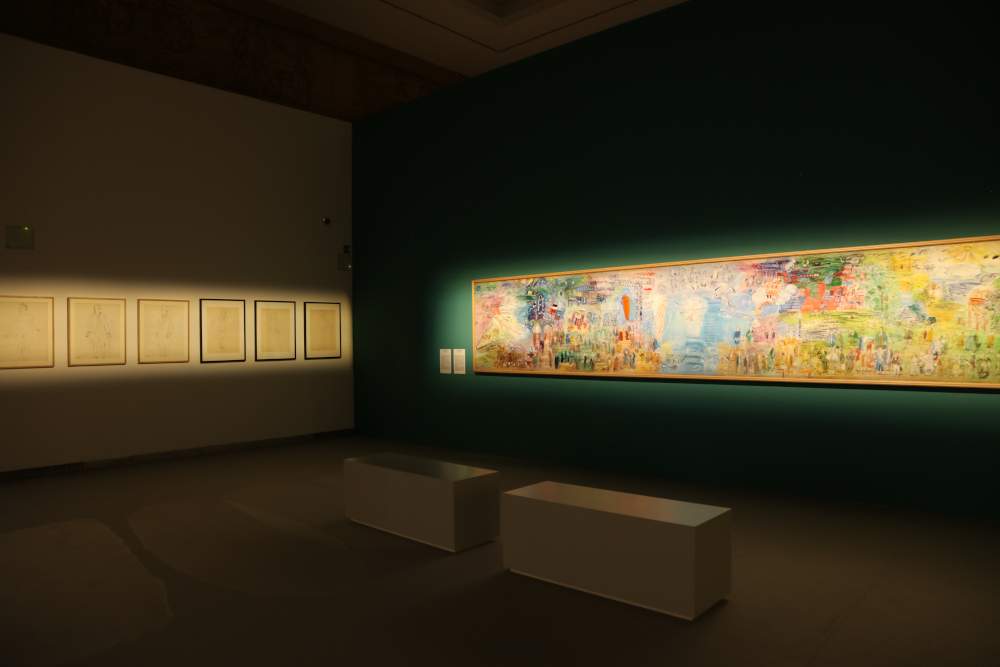Rome, at Palazzo Cipolla a major exhibition dedicated to Raoul Dufy, painter of joy
Until February 26, 2023, Palazzo Cipolla in Rome is hosting in its halls the exhibition Raoul Dufy. The Painter of Joy, curated by Sophie Krebs, general curator of the Musée d’Art Moderne de la Ville de Paris, promoted by the Fondazione Terzo Pilastro - Internazionale; it is produced by Poema with the organizational support of Comediarting and Arthemisia, and conceived by the Musée d’Art Moderne de la Ville de Paris. It is a major exhibition dedicated to Raoul Dufy (Le Havre, 1877 - Forcalquier, 1953).
Author of monumental works such as La Fée Electricité (1937 - 1938), one of the largest paintings in the world, with a total length of 6 meters, composed of 250 panels and commissioned by the Compagnie parisienne de distribution d’électricité to be exhibited in the Pavilion ofelectricity at the 1937 World’s World, Dufy was a great early 20th-century French painter, scenographer and draftsman who became the painter of joy and light because of his ability to capture atmospheres, colors and intensity on canvas.
Born into a family of modest economic circumstances, he had an organist father who transferred his own passion for music to Raoul in particular. Following a family financial crisis, young Raoul was forced to seek work in Le Havre in 1891. In Paris he became close to two masters such as Monet and Pissarro but, in 1905, the scandal of the Fauves revealed to him a modern painting that led him to approach Matisse. 1903 was the year of his first time at the Salon des Indépendants, in which he exhibited until 1936 and then was accepted in 1906 at the Salon d’Automne (until 1943). His artistic activity was uninterrupted and, from 1910, he expanded his activity in the field of decorative arts, successfully establishing himself in a wide range of production, from woodcuts to paintings and graphics, from ceramics to textiles, from illustrations to stage designs.
On display are more than 160 works including paintings, drawings, ceramics and textiles from major public and private collections in France, such as the Musée d’Art Moderne de la Ville de Paris, which holds one of Dufy’s richest collections, from the Centre Pompidou, Palais Galliera, the Bibliothèque Forney and the Bibliothèque littéraire Jacques Doucet, all in Paris, along with the Musée de la Loire, Musée des Tissus et des Arts Décoratifs in Lyon, the Musée des Beaux-Arts Jules Chéret in Nice and the Musée Royaux des Beaux-Arts de Belgique in Brussels. Through these works it is intended to recount the life and work of an artist with his gaze always turned to modernity. The exhibition presents the artist’s favorite themes, where visual sensations reduced to the essence of reality, the use of composition, light and color are the most significant elements that characterize his works.
Divided into fourteen thematic sections, the exhibition recounts the French painter’s entire artistic journey through works that embrace various techniques in the different decades of the 20th century, from the beginnings until the 1950s, when Dufy sought new themes due to the war and illness that forced him to remain in his studio in the south of France. An excursus that finds its leitmotif in chromatic violence, in the magic of color. An evolution that sees the artist initially a continuer of that Impressionist tradition born with Monet in his very hometown of Le Havre and then together with the Fauves who, gathered around the figure of Matisse, would soon react to atmospheric painting and then come to embrace the Cezannean austerity with which forms, flat areas of bright colors are independent of line.
Inverted V waves, clouds and a world of forms: bathers, birds, horses, landscapes inspired by both modernity and classicism. Sensitive to the air of his own time, he is interested in the society of entertainment with its races, regattas, and shows at once elitist and popular, which Dufy reproduces with brio and vivacity. An artist in constant search of stimulation and experimentation, able to make art that was engaged but at the same time seemingly light, whose stated purpose was to bring pleasure.
“I am very pleased to host, at the exhibition space of Palazzo Cipolla, an exhibition on Raoul Dufy, which is re-proposed in Rome after almost forty years of oblivion (the first and only exhibition on Dufy in the Capital, before today, was in fact that of 1984 at Villa Medici),” said Emmanuele F. M. Emanuele, president of Fondazione Terzo Pilastro - Internazionale. “Often not thoroughly understood, due to the apparent simplicity of his pictorial line, which has not infrequently caused him to be given the patents of superficiality and worldliness, Raoul Dufy actually had an articulate and complex education: he was initially influenced by Impressionism, masterfully perpetuating the tradition of Monet and relying on the peculiarity of being a ’colorist by temperament’; later, he approached Fauvism by drawing inspiration from the figures of Matisse, Braque and Cézanne. Dufy’s peculiarity lies in his gradual dissociation, over the course of his artistic maturation, of color from drawing, simplifying as much as possible and thus putting form before content. He, following his own theory that color served painters to capture light, traveled extensively in the Mediterranean, particularly in Provence (where he settled) and southern Italy. Hence the famous landscapes, bathers, wheat fields, and then concert halls and especially regattas, horse races and racetracks, to depict the leisure society of the 1920s and 1930s, which would make him popular with the public.”
 |
| Rome, at Palazzo Cipolla a major exhibition dedicated to Raoul Dufy, painter of joy |
Warning: the translation into English of the original Italian article was created using automatic tools. We undertake to review all articles, but we do not guarantee the total absence of inaccuracies in the translation due to the program. You can find the original by clicking on the ITA button. If you find any mistake,please contact us.




























